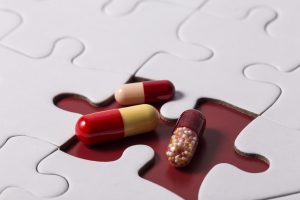
The use of systemic antibiotics as an adjunct to periodontal disease have been utilized for decades1. With the emergence of systemic antibiotic stewardship, a responsible approach to administering a systemic antibiotic with periodontal care is warranted. The overall “cocktail” approach-selecting a systemic antibiotic to blanket everything-could be contributing to rise in antibiotic resistance. However, a systematic approach of testing and utilizing an evidence based recommendation helps you achieve a responsible approach.
After a periodontal assessment indicating inflammation, administer a MyPerioPath® to confirm the presence of bacteria triggering the inflammatory response. Please note periodontal bacteria usually plays a significant role with periodontal inflammation but is not always the cause or only cause of the inflammation. If the MyPerioPath® results reveal the bacterial load is significant, then the use of a systemic antibiotic in conjunction with biofilm disruption can be considered. An evidence based recommendation will be printed on most MyPerioPath reports, if there isn’t an option then there is a link to the MyPerioPath Antibiotic Options. When considering the use of a systemic antibiotic, the prescribing doctor is responsible and should consider the patient’s dental and medical history (e.g. pregnancy/nursing, diabetes, immuno-suppression, other patient medications) when evaluating the use of antibiotic medications. Many antibiotics may impact/interact with other medications and may produce adverse side effects. Review the manufacturer warnings for any contraindications, or consult with the patient’s physician if there are concerns with the selected antibiotic regimen.
The antibiotic is best administrated following the biofilm disruption2. The mechanical debridement disrupts the protective matrix of the biofilm so the bacteria is free-floating. When the biofilm is in a plankton/free floating state, the systemic antibiotic can be more effective. Another option would be to administer the systemic antibiotic 1-2 days before a full mouth biofilm disruption3, especially for high risk patients such as diabetes or cardiovascular patients.
Other adjunctive therapy, such as localized antimicrobials, can be administered at the same time as the systemic antibiotic. Overall, several modes of therapy can be successful when addressing periodontal inflammation. Utilizing an objective diagnostic test, like MyPerioPath® before therapy, confirms if a bacterial reduction approach is warranted and gives an evidenced based systemic antibiotic option- Personalized care. This approach allows the clinician to administer the antibiotic responsibly.
References
- Kapoor, A., Malhotra, R., Grover, V., & Grover, D. (2012). Systemic antibiotic therapy in periodontics. Dental Research Journal, 9(5), 505. doi:10.4103/1735-3327.104866
- Sigmund S. Socransky and Anne D. Haffajee. Dental biofilms: Difficult therapeutic targets. Periodontology 2000 28 (2008): 12-55.
- Slots J, MacDonald ES, Nowzari H. Infectious aspects of periodontal regeneration. Periodontol 2000. 1999;19:164–72.
For more information on how to become an OralDNA Provider – scan HERE: 
- Practicing Dental Medicine: The Partnership with a Clinical Laboratory - December 13, 2024
- Olympic Spirit: Achieving Gold in Healthcare - August 16, 2024
- The Winning Team: The Healthcare Provider & The Clinical Laboratory - April 12, 2024
